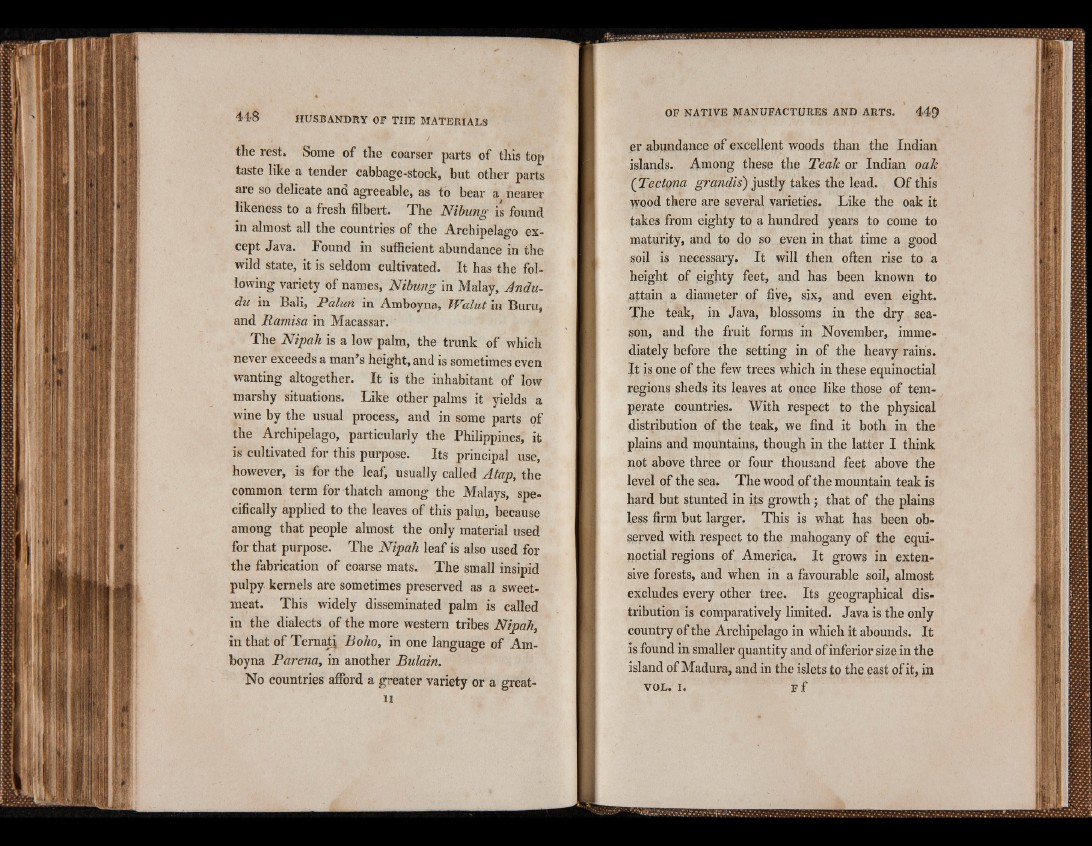
the rest. Some of the coarser parts of this top
taste like a tender cabbage-stock, but other parts
are so delicate anu agreeable, as to bear a nearer
likeness to a fresh filbert. The Nibung is found
in almost all the countries of the Archipelago except
Java. Found in sufficient abundance in the
wild state, it is seldom cultivated. It has the following
variety of names, Nibung in Malay, Andu-
du in Bali, Paliin in Amboyna, JValut in Buru,
and Ramisa in Macassar.
The Nipah is a low palm, the trunk of which
never exceeds a man’s height, and is sometimes even
wanting altogether. It is the inhabitant of low
marshy situations. Like other palms it yields a
wine by the usual process, and in some parts of
the Archipelago, particularly the Philippines, it
is cultivated for this purpose. Its principal use,
however, is for the leaf, usually called A tap, the
common term for thatch among the Malays, specifically
applied to the leaves of this palm, because
among that people almost the only material used
for that purpose. The Nipah leaf is also used for
the fabrication of coarse mats. The small insipid
pulpy kernels ate sometimes preserved as a sweetmeat.
This widely disseminated palm is called
in the dialects of the more western tribes Nipah,
in that of Ternatj Boho, in one language of Amboyna
Parena, in another Bulain.
No countries afford a greater variety or a great-
11
er abundance of excellent woods than the Indian
islands. Among these the Teak or Indian oak
( Tectona grandis) justly takes the lead. Of this
wood there are several varieties. Like the oak it
takes from eighty to a hundred years to come to
maturity, and to do so even in that time a good
soil is necessary. It will then often rise to a
height of eighty feet, and has been known to
attain a diameter of five, six, and even eight.
The teak, in Java, blossoms in the dry season,
and the fruit forms in November, immediately
before the setting in of the heavy rains.
It is one of the few trees which in these equinoctial
regions sheds its leaves at once like those of temperate
countries. With respect to the physical
distribution of the teak, we find it both in the
plains and mountains, though in the latter I think
not above three or four thousand feet above the
level of the sea. The wood of the mountain teak is
hard but stunted in its growth; that of the plains
less firm but larger, This is what has been observed
with respect to the mahogany of the equinoctial
regions of America. It grows in extensive
forests, and when in a favourable soil, almost
excludes every other tree. Its geographical distribution
is comparatively limited. Java is the only
country of the Archipelago in which it abounds. It
is found in smaller quantity and of inferior size in the
island of Madura, and in the islets to the east of it, in
v o l . i . r f